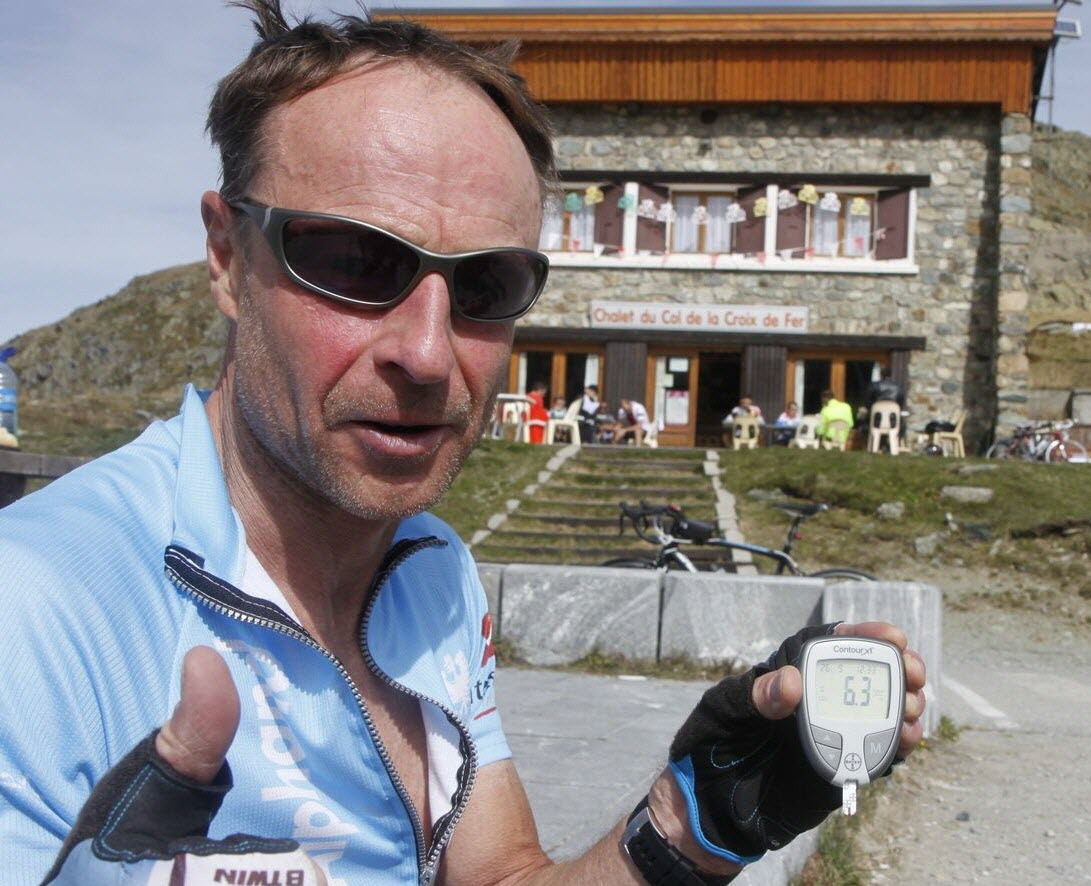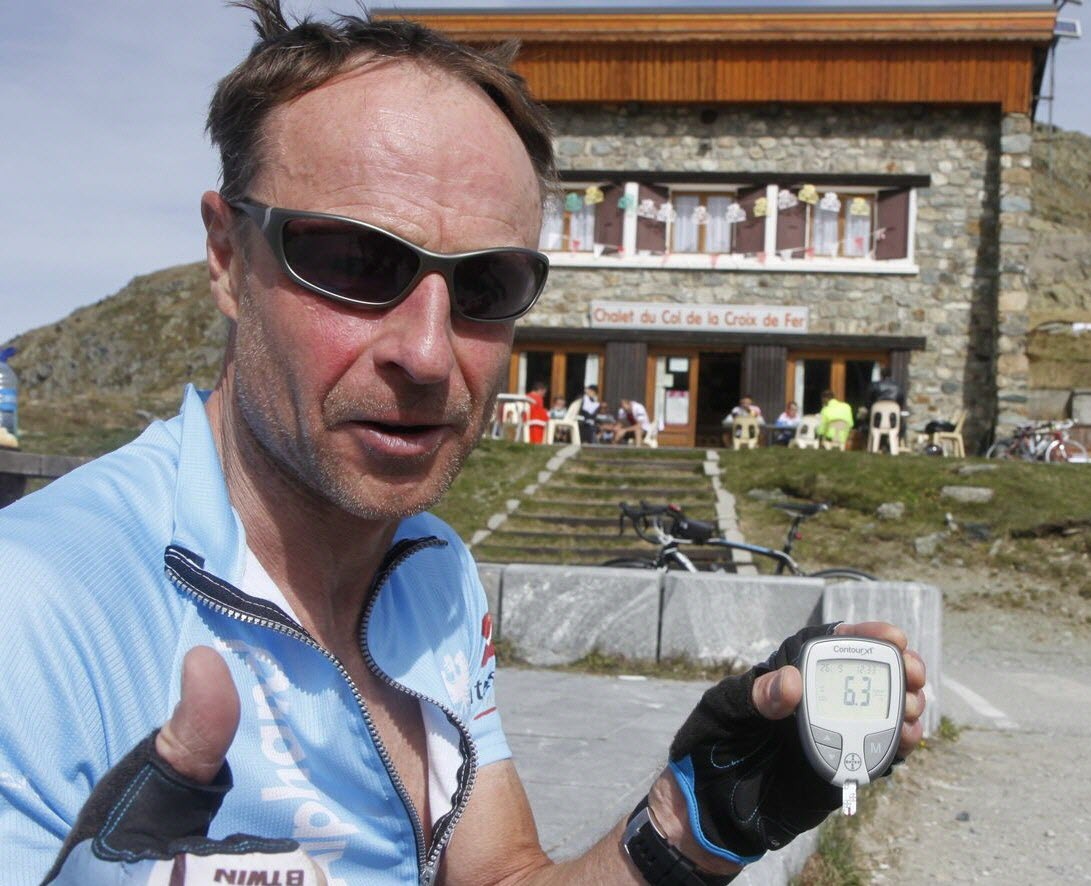 Advice for Patients
Advice for Patients

ROAR with T1D Jerry Gore

I got all the T1D symptoms over a two-day period, aged 40 in Jan 2001. I was attending the first weekend of an intensive marketing diploma, but I had not counted on just how intensive it really was! I was crushed. I had just been made redundant from a job I had given everything to for a decade. I was the father of two vulnerable daughters under 5, a husband to a loving wife who depended on my salary, and in my spare time, a professional climber who had just been told his expedition days were now over. It took me a few weeks to accept I had a chronic health condition and the rest of my life (to date) trying to understand it. But I am fortunate. First of all, I am British, and we have a health system. So that means free insulin, test strips and education. Secondly I have an enquiring mind coupled with a high level of energy, as does Jackie. Her approach was to start reading all about T1D. Mine was to network and look for peer support; a former Royal Marine, I am a trained team player. And it soon became obvious to me that I needed to find like-minded people with T1D who did the same things that I did - climbing, hiking and mountain biking.
My first bad hypo occurred whilst leading a difficult and technical rock climb in Avon Gorge, near Bristol. Half way up a 70m. sheer rock wall, looking at a ground fall that I would not walk away from, the energy just started draining from fingers. I was holding on literally by my fingertips and they started ever so slowly to unfold. I screamed down at my climbing partner Chris, and he screamed right back with “don’t fall Jerry. Get some pro in fast”. This meant I had to fiddle in a “nut” – a tiny piece of metal no bigger than my thumb nail, into a thin crack in front of my nose. And then attach my rope to it to save me from falling to the ground. In my weakening state, with trembling hands, covered in sweat, feeling confused and dizzy, I tried to focus and obey his command. I put my heart and soul into it, because that what was at stake. After an age of literally fighting with that sliver of metal, I clipped the rope and immediately fell…..a long way. I had nothing left.
Amazingly the protection piece held and as I dangled inches above my astonished partner, the rope went from Chris on the ground, all the way up to that minuscule nut and back down to me! I learnt my first rule as a climber with T1D – always test before you climb and carry a Twix just in case!
There is a lot to say, so I will be as brief as I can. The editor (I promised Richard I would never mention him by name) only gave me a 1000 words and the full story is in my book out this autumn (shameless plug!). But since that disastrous start, back in 2001, Jackie and I moved our family out to the French alps, set up two companies and together with my oldest mate Charles Toomey, co-founded the charity Action4Diabetes in SE Asia. I was made a Blue Circle champion and became an ambassador for the International Diabetes Federation. And every year since 2004 I have done a JIC - Jerry’s Insulin Challenge (https://jerrygore.com/jerrys-insulin-challenges) to raise money for impoverished children with T1D. My JIC’s include a UK record speed climb on the North face of The Eiger in Switzerland, new routes on remote mountains from Patagonia to the Himalayas, and a fundraising cycle ride from London to Kyiv in Ukraine for children with T1D living close to the front line.
So, what have I actually learned about living with this complex condition? In short, T1D for me is a lifestyle condition and living well with it is all about having a lifestyle that is right for you and that makes you happy. Shortly after my diagnosis, I decided to adapt my condition to my life and NOT my life to diabetes. By so doing I have continued, best as I can, to live my life the way I want to.
I don’t love technology. I have an ageing 63-year-old body, and I am rubbish with numbers – failed my maths O’level (Old school GCSE’s) twice. I am also very impatient and am very trigger-happy when it comes to insulin injections. I find living with T1D a daily hassle and often very frustrating. But I manage because I am living the life I want to. T1D just has to fit in with that, and it mostly does.
I have broken my neck twice, been directly struck by lightning on a remote peak and very nearly died. I have been avalanched in -30C and managed to rescue my partner who had broken his femur. I have had climbing partners die in front of me in a storm at 6,000m., and I have been attacked by a Himalayan bear and had my rucksack destroyed. Yet I have still found living with T1D the most challenging thing that I have had to deal with. Not in terms of intensity, but longevity. T1D is relentless, no holidays, no breaks and always 24/7. Yet we all have to deal with it when it comes knocking.
In terms of my medication and equipment I rely on the government health system for everything. I use a Freestyle Libre backed up by an Ascensia Contour Plus BGM. At altitudes above 4,000m. I find the freestyle does not work so well and that is when I start relying on my Contour. It is the best. I use pens because they allow me the freedom I need for activities like ice climbing, and XC skiing. I tried a pump for two years but did not find it liked remote environments or really dirty conditions I would experience on climbing trips. I inject Levemir twice daily, once before breakfast and once before my evening meal. I inject Humalog at least 4 times a day. I change my doses regularly based on what I am eating and what exercise I have just done or am about to. I try not to snack but fail daily, so I inject instead. I try to carb count, but it becomes impossible when working for my charity in SE Asia. To date Action4Diabetes supports more than 1,000 children with T1D spread across 35 clinics in 7 different countries. The food I will typically consume in Asia will range from a crusty shrivelled sandwich to posh corporate banquets. So, my system is to inject a standard amount of Humalog (normally 5 units) and then test every hour over the next few hours.
I do a few things almost every day which help me with my condition and which I hope will help some people who struggle with their condition.
1. I look after my mental as well as my physical health by going to my medicine cabinet as much as I can. But my cabinet is located outdoors, not inside my house. I try and go for at least a short walk, or bike ride every day for at least 30 minutes. The outdoors is where I heal my hurts, and every time I do exercise outside I feel positive. That positivity helps my motivation, which in turn makes me want to control my ever-changing sugar levels and helps my blood sugar control the following day.
2. Knowledge is king – every day I try and learn a bit more about my condition, often by talking and interacting with T1D peers, and hopefully with a pint or two or a nice coffee and a biscuit.
3. Low carbs, high fats and protein: I eat anything, but I tend to really cut down on carbs, especially pasta and chips. And zero amounts of sugary drinks like Coke or Pepsi.
To sum up my way of dealing with T1D I created a phrase that I live by and invented an anacronym that describes my approach. The phrase is “Diabetes is NOT an excuse”. And the anacronym is ROAR – Risk, Organisation, Action, Results. I ROAR at my condition and that gives me confidence and helps reduce the fear I have about living with T1D.
RISK: We all have to deal with the risks of living a full life with T1D, so to reduce it I try as best I can to put my energies into trying to maintain good sugar levels, rather than worry about things like T1D complications and DKA etc. In this way I put the risk into perspective and can deal with it, knowing I am doing my best.
ORGANISATION: In order to do the things I want to living with T1D, I have to organise everything in detail. When I go for a big climb in the mountains, I am drawing on the cumulative experience and prior preparation gained from hundreds of previous climbs, and enduring numerous hypos, and hypers. I often try out different levels and types of insulin, as well as different BGM’s and specially designed protective pouches.
ACTION: I regularly put my learning and experimentation into action. I love seeing how my body responds and what I can achieve both mentally and physically. I believe in experimenting and “playing” with my condition, carefully, in controlled situations. Otherwise, I would just be “living in fear”, always worried that something might happen that I did not know about, or was not able to control, or that I had not experienced.
RESULTS: Finally, I gain results which lead to increased confidence, motivation and therefore better blood sugar control.
My last JIC was my cycle ride to Ukraine last year. I "roared" loudly when we cycled into Kyiv late at night after covering 200km in just eight hours. It was on the back of 25 days of cycling across Europe eating different foods for every meal of every day, all on pens and with no support. The team was just Paul Buckley my cycling partner, our incredible Ukrainian cycling guide Alex and me. Paul and I cycled 3,200Km on that trip. Neither of us had ever done anything like it before. And I had met Paul for literally one hour, 2 months before we started our ride. He does not live with T1D yet was incredibly patient and understanding of all my mood-swings, hypos and hypers. And as we hugged on the streets of Kyiv that last night, even he agreed, “Diabetes is NOT an excuse!”
